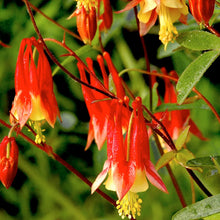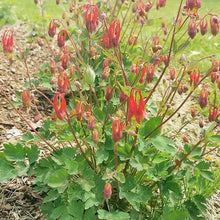Aquilegia canadensis is a delicate and graceful native wildflower known for its nodding red and yellow spurred flowers that bloom in spring. Self sows lightly in hospitable settings creating soft drifts that support native wildlife.
Height & Spread: 24 - 36 in x 12 - 18 in
Bloom Time: Mid spring to early summer
Light Requirements: Part shade to full sun in cooler climates
Soil Preference: Well drained, average to moist soil with good organic content
Watering Needs: Moderate; appreciates even moisture but tolerates short dry periods
Deer Resistance: Moderately deer resistant; young growth may be browsed
Native Status
This species is native to eastern and central North America, commonly found in open woodlands, rocky slopes, and along bluffs or ledges.
WILDLIFE & INSECTS
Hummingbirds
- Highly attractive to Ruby Throated Hummingbirds, which feed on the nectar from the plant’s long spurred red flowers.
Butterflies
- Visited by early flying butterflies such as Spring Azures and Clouded Sulphurs for nectar.
Bees
- Supports bumblebees and mining bees which access the nectar and help pollinate the blooms.
Spacing & Landscape Use
Spacing Recommendations
- Space 12 - 18 in apart to accommodate natural self seeding and airy clump formation.
Landscape Placement
- Excellent for woodland edges, shaded pollinator gardens, native plantings, and naturalistic garden borders. Best planted in masses or informal clusters.
Companion Plants
- Geranium maculatum (Wild Geranium) - Offers spring bloom overlap and similar woodland soil preferences.
- Dicentra eximia (Fringed Bleeding Heart) - Provides fine textured foliage and pink blooms that complement columbine flowers.
- Mertensia virginica (Virginia Bluebells) - Adds early spring color and soft blue tones to woodland plantings.
- Carex pennsylvanica (Pennsylvania Sedge) - Provides a native, low grass-like ground cover to fill between columbine groupings.
- Asarum canadense (Wild Ginger) - Offers bold foliage and deep shade adaptability for layering beneath columbine clumps.



